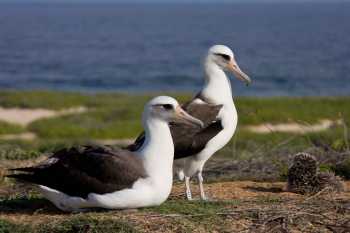Eric Vanderwerf and Lindsay Young of Pacific Rim Conservation have analysed eight years of demographic data collected from Laysan Albatrosses Phoebastria immutabilis breeding at Kaena Point (site of a new predator-proof fence) on Oahu, Hawaii.The paper's abstract follows:
"Accurate estimates of demographic rates are fundamental to understanding population dynamics and can provide insights into the ecology and conservation of a species. We used multistate mark-recapture models to estimate apparent annual survival, encounter probability, and life-stage transitions in Laysan Albatrosses (Phoebastria immutabilis) at Kaena Point, Hawaii, from 2003 to 2010. Four-state models of prebreeders, breeders, failed breeders, and skipped breeders overestimated survival by 1-3% and underestimated skipped breeding by 5-6%, but five-state models that included a state for unobserved skipped breeders performed better. Survival did not vary among years and was highest in prebreeders (mean ± SE = 0.996 ± 0.010) and lower in successful breeders (0.932 ± 0.023) than in failed breeders (0.963 ± 0.018), suggesting a cost to reproduction. Survival was similar in males and females among prebreeders, breeders, and failed breeders, but survival of males was lower among skipped breeders. Encounter probability was related to monitoring effort; more frequent visits and use of field-readable auxiliary bands and remote cameras resulted in higher encounter rates. With sufficient effort, all skipped breeders were observed at the colony even though they did not breed. Recruitment averaged 24% in females and 21% in males and varied among years. Breeding frequency averaged 0.807 ± 0.028 and varied among years. Successful breeders were more likely than failed breeders to skip the next breeding season. Estimates of all demographic rates except recruitment were similar to estimates for Laysan Albatrosses from Midway in the 1960s despite differences in methodology. This information can help measure population dynamics, breeding population sizes, population trends, and efficacy of conservation actions."

Laysan Albatross pair with their chick at Kaena Point
Photograph by Lindsay Young
Reference:
VanderWerf, E.A & Young, L.C. 2011. Estimating survival and life-stage transitions in the Laysan Albatross (Phoebastria immutabilis) using multistate mark-recapture models. The Auk 128: 726-736.
With thanks to Eric Vanderwerf for information.
John Cooper, ACAP Information Officer, 18 November 2011

 English
English  Français
Français  Español
Español